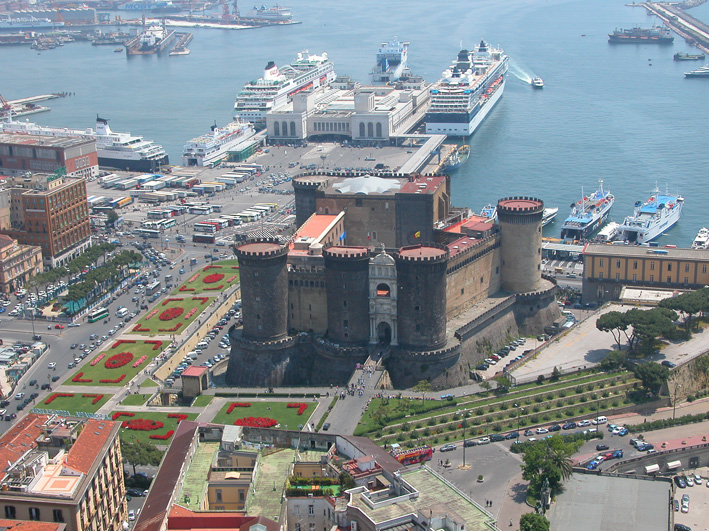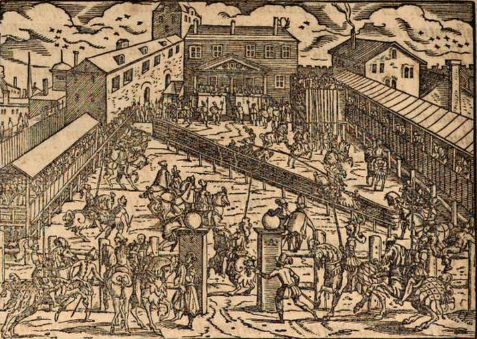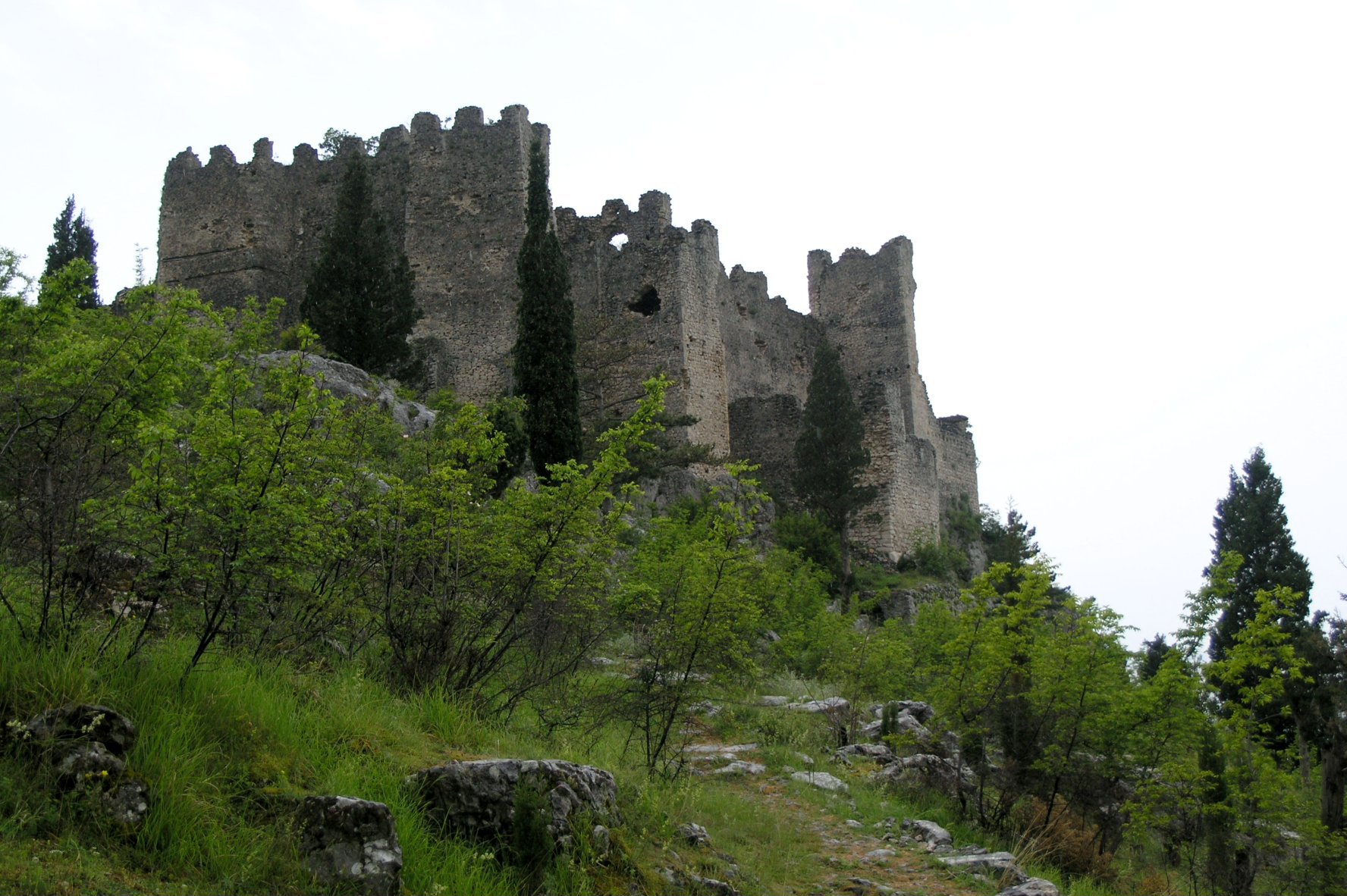|
Alfonso V Of Naples
Alfonso the Magnanimous (139627 June 1458) was King of Aragon and King of Sicily (as Alfonso V) and the ruler of the Crown of Aragon from 1416 and King of Naples (as Alfonso I) from 1442 until his death. He was involved with struggles to the throne of the Kingdom of Naples with Louis III of Anjou, Joanna II of Naples and their supporters, but ultimately failed and lost Naples in 1424. He recaptured it in 1442 and was crowned king of Naples. He had good relations with his vassal, Stjepan Kosača, and his ally, Skanderbeg, providing assistance in their struggles in the Balkans. He led diplomatic contacts with the Ethiopian Empire and was a prominent political figure of the early Renaissance, being a supporter of literature as well as commissioning several constructions for the Castel Nuovo. Early life Born at Medina del Campo, he was the son of Ferdinand of Trastámara and Eleanor of Alburquerque. Ferdinand was the brother of King Henry III of Castile, and Alfonso wa ... [...More Info...] [...Related Items...] OR: [Wikipedia] [Google] [Baidu] |
Knight Of The Golden Fleece
This article contains a list of knights of the Order of the Golden Fleece. Knights of the Burgundian Golden Fleece 15th Century !Year of Induction!!Name!!Born!!Died!!Notes , - , rowspan=25, 1430, , Philip the Good, Duke of Burgundy, , 1396, , 1467, , Founder and First Head of the Order , - , Guillaume de Vienne, Seigneur de Saint-George, , 1360, , 1435, , , - , Regnier Pot, Seigneur de la Prugne, , ?, , 1432, , , - , Jehan, Seigneur de Roubaix, , 1369, , 1449, , , - , Roland d'Uutkercke, Seigneur de Hemsrode, , ?, , 1442, , , - , Antoine de Vergy, Comte de Dammartin, , ?, , 1439, , , - , David de Brimeu, Seigneur de Ligny, , ?, , 1451, , , - , Hue de Lannoy, Seigneur de Santes, , 1384, , 1456, , , - , Jehan, Seigneur de Comines, , ?, , 1442, , , - , Antoine de Toulonjon, , ?, , 1432, , Marshal of Burgundy , - , Pierre de Luxembourg, Comte de Saint-Pol, , 1390, , 1433, , , - , Jehan de la Trémoille, Seigneur ... [...More Info...] [...Related Items...] OR: [Wikipedia] [Google] [Baidu] |
Crown Of Aragon
The Crown of Aragon ( , ) an, Corona d'Aragón ; ca, Corona d'Aragó, , , ; es, Corona de Aragón ; la, Corona Aragonum . was a composite monarchy ruled by one king, originated by the dynastic union of the Kingdom of Aragon and the County of Barcelona and ended as a consequence of the War of the Spanish Succession. At the height of its power in the 14th and 15th centuries, the Crown of Aragon was a thalassocracy controlling a large portion of present-day eastern Spain, parts of what is now southern France, and a Mediterranean empire which included the Balearic Islands, Sicily, Corsica, Sardinia, Malta, Southern Italy (from 1442) and parts of Greece (until 1388). The component realms of the Crown were not united politically except at the level of the king, who ruled over each autonomous polity according to its own laws, raising funds under each tax structure, dealing separately with each ''Corts'' or ''Cortes'', particularly the Kingdom of Aragon, the Principality of Catalonia, ... [...More Info...] [...Related Items...] OR: [Wikipedia] [Google] [Baidu] |
Castel Nuovo
Castel Nuovo (; "New Castle"), often called Maschio Angioino (; "Angevin Keep"), is a medieval castle located in front of Piazza Municipio and the city hall ( Palazzo San Giacomo) in central Naples, Campania, Italy. Its scenic location and imposing size makes the castle, first erected in 1279, one of the main architectural landmarks of the city. It was a royal seat for kings of Naples, Aragon and Spain until 1815. It is the headquarters of Neapolitan Society of Homeland History and of the Naples Committee of the Institute for the History of the Italian Risorgimento. In the complex there is also the civic museum, which includes the Palatine Chapel and the museum paths on the first and second floors. History The origins and the dynasty of the House of Anjou The construction of its former nucleus -today partly re-emerged following restoration and archaeological exploration work- is due to the initiative of Charles I of Anjou, who in 1266, defeated the Hohenstaufens, ascend ... [...More Info...] [...Related Items...] OR: [Wikipedia] [Google] [Baidu] |
Renaissance
The Renaissance ( , ) , from , with the same meanings. is a period in European history marking the transition from the Middle Ages to modernity and covering the 15th and 16th centuries, characterized by an effort to revive and surpass ideas and achievements of classical antiquity. It occurred after the Crisis of the Late Middle Ages and was associated with great social change. In addition to the standard periodization, proponents of a "long Renaissance" may put its beginning in the 14th century and its end in the 17th century. The traditional view focuses more on the early modern aspects of the Renaissance and argues that it was a break from the past, but many historians today focus more on its medieval aspects and argue that it was an extension of the Middle Ages. However, the beginnings of the period – the early Renaissance of the 15th century and the Italian Proto-Renaissance from around 1250 or 1300 – overlap considerably with the Late Middle Ages, conventionally da ... [...More Info...] [...Related Items...] OR: [Wikipedia] [Google] [Baidu] |
Ethiopian Empire
The Ethiopian Empire (), also formerly known by the exonym Abyssinia, or just simply known as Ethiopia (; Amharic and Tigrinya: ኢትዮጵያ , , Oromo: Itoophiyaa, Somali: Itoobiya, Afar: ''Itiyoophiyaa''), was an empire that historically spanned the geographical area of present-day Ethiopia and Eritrea from the establishment of the Solomonic dynasty by Yekuno Amlak approximately in 1270 until the 1974 coup d'etat of Emperor Haile Selassie by the Derg. By 1896, the Empire incorporated other regions such as Hararghe, Gurage and Wolayita, and saw its largest expansion with the federation of Eritrea in 1952. Throughout much of its existence, it was surrounded by hostile forces in the African Horn; however, it managed to develop and preserve a kingdom based on its ancient form of Christianity. Founded in 1270 by the Solomonic Dynasty nobleman Yekuno Amlak, who claimed to descend from the last Aksumite king and ultimately the Biblical Menelik I and the Queen of Sheba, i ... [...More Info...] [...Related Items...] OR: [Wikipedia] [Google] [Baidu] |
Balkans
The Balkans ( ), also known as the Balkan Peninsula, is a geographical area in southeastern Europe with various geographical and historical definitions. The region takes its name from the Balkan Mountains that stretch throughout the whole of Bulgaria. The Balkan Peninsula is bordered by the Adriatic Sea in the northwest, the Ionian Sea in the southwest, the Aegean Sea in the south, the Turkish Straits in the east, and the Black Sea in the northeast. The northern border of the peninsula is variously defined. The highest point of the Balkans is Mount Musala, , in the Rila mountain range, Bulgaria. The concept of the Balkan Peninsula was created by the German geographer August Zeune in 1808, who mistakenly considered the Balkan Mountains the dominant mountain system of Southeast Europe spanning from the Adriatic Sea to the Black Sea. The term ''Balkan Peninsula'' was a synonym for Rumelia in the 19th century, the European provinces of the Ottoman Empire. It had a ge ... [...More Info...] [...Related Items...] OR: [Wikipedia] [Google] [Baidu] |
Skanderbeg
, reign = 28 November 1443 – 17 January 1468 , predecessor = Gjon Kastrioti , successor = Gjon Kastrioti II , spouse = Donika Arianiti , issue = Gjon Kastrioti II , royal house = Kastrioti , father = Gjon Kastrioti , mother = Voisava Kastrioti , birth_name = Gjergj ( see Name) , birth_date = 1405 , birth_place = Principality of Kastrioti , death_date = 17 January 1468 (aged 62) , death_place = Alessio, Republic of Venice , place of burial = Church of Saint Nicholas, Lezhë , religion = Islam Catholicism , occupation = Lord of the Principality of Kastrioti, , signature = Dorëshkrimi i Skënderbeut.svg Gjergj Kastrioti ( la, Georgius Castriota; it, Giorgio Castriota; 1405 – 17 January 1468), commonly known as Skanderbeg ( sq, Skënderbeu or ''Skënderbej'', from ota, اسکندر بگ, İskender Bey; it, Scanderbeg), was an Albanian feudal lord and military commander who led a rebellion ag ... [...More Info...] [...Related Items...] OR: [Wikipedia] [Google] [Baidu] |
Stjepan Vukčić Kosača
Stjepan Vukčić Kosača ( sr-Cyrl, Стјепан Вукчић Косача; 1404–1466) was the most powerful Bosnian nobleman whose active political career spanned the last three decades of medieval Bosnian history, from 1435 to 1465. During this period, three kings succeeded to the Bosnian throne, Tvrtko II, Thomas ''(Tomaš)'', Stephen Tomašević ''(Stjepan Tomašević)'', one anti-king, Radivoj, the older brother of King Thomas, and the county's fate was sealed by the Ottoman conquest. He was probably born in 1404, a son of the Knyaz of Drina, Vukac Hranić, and Katarina, whose ancestry is unknown. Stjepan's father's hereditary lands were in the Upper Drina region. A member of the Kosača noble family, he succeeded his uncle, Duke Sandalj, as duke of Humska zemlja and the Grand Duke of Bosnia, in 1435. None influenced the development of the late Bosnian medieval state as much as Stjepan Vukčić did. Supporting Radivoj in the line of succession for ... [...More Info...] [...Related Items...] OR: [Wikipedia] [Google] [Baidu] |
Joanna II Of Naples
Joanna II (25 June 1371 – 2 February 1435) was reigning Queen of Naples from 1414 to her death, upon which the Capetian House of Anjou became extinct. As a mere formality, she used the title of Queen of Jerusalem, Sicily, and Hungary. Early life Joanna was born at Zara (present-day Zadar, Croatia), on 25 June 1371, as the daughter of Charles III of Naples and Margaret of Durazzo.Guida Myrl Jackson-Laufer, ''Women Rulers Throughout the Ages: An Illustrated Guide'', (ABC-CLIO, 1999), 201-202. After 1386 Marie of Blois Duchess Dowager of Anjou started negotiations about her son Louis II of Anjou's marriage with Joanna, but Louis flatly refused to marry the daughter of his father's principal enemy in May 1387. Joanna married her first husband, William, Duke of Austria, in Vienna in the autumn of 1401 when she was 28 years of age. He had been rejected as a husband by her cousin, Queen Hedwig of Poland. Joanna did not have any children by William, who died in 1406 after five ye ... [...More Info...] [...Related Items...] OR: [Wikipedia] [Google] [Baidu] |
Louis III Of Anjou
Louis III (25 September 1403 – 12 November 1434) was a claimant to the Kingdom of Naples from 1417 to 1426, as well as count of Provence, Forcalquier, Piedmont, and Maine and duke of Anjou from 1417 to 1434. As the heir designate to the throne of Naples, he was duke of Calabria from 1426 to 1434. Claim to Aragon Louis was the eldest son and heir of Louis II of Anjou and Yolande of Aragon. The throne of the Crown of Aragon fell vacant in 1410 when Yolande's uncle King Martin died. As the daughter of King John I of Aragon, Martin's brother and predecessor, Yolande claimed the throne of Aragon for the young Louis. However, unclear though they were, the succession rules of the Kingdom of Aragon and the County of Barcelona at that time were understood to favor all male relatives before any female. Martin died without surviving issue in 1410, and after two years without a king, the Estates of Aragon by Compromise of Caspe in 1412 elected Martin's nephew Ferdinand of Castile as the nex ... [...More Info...] [...Related Items...] OR: [Wikipedia] [Google] [Baidu] |
Count Of Barcelona
The Count of Barcelona ( ca, Comte de Barcelona, es, Conde de Barcelona, french: Comte de Barcelone, ) was the ruler of the County of Barcelona and also, by extension and according with the Usages of Barcelona, usages and Catalan constitutions, of the Principality of Catalonia as Prince#Prince as generic for ruler, Princeps for much of History of Catalonia, Catalan history, from the 9th century until the 18th century. History The County of Barcelona was created by Charlemagne after he had conquered lands north of the river Ebro and Barcelona, after a Siege of Barcelona (801), siege in 801. These lands, called the ''Marca Hispanica'', were partitioned into various counties, of which the count of Barcelona, usually holding other counties simultaneously, eventually obtained the primacy over the region. As the county became hereditary in one family, the bond of the counts to their Frankish overlords loosened, especially after the Capetian dynasty supplanted the Carolingians. In the 1 ... [...More Info...] [...Related Items...] OR: [Wikipedia] [Google] [Baidu] |
Kingdom Of Sicily
The Kingdom of Sicily ( la, Regnum Siciliae; it, Regno di Sicilia; scn, Regnu di Sicilia) was a state that existed in the south of the Italian Peninsula and for a time the region of Ifriqiya from its founding by Roger II of Sicily in 1130 until 1816. It was a successor state of the County of Sicily, which had been founded in 1071 during the Norman conquest of the southern peninsula. The island was divided into three regions: Val di Mazara, Val Demone and Val di Noto. In 1282, a revolt against Angevin rule, known as the Sicilian Vespers, threw off Charles of Anjou's rule of the island of Sicily. The Angevins managed to maintain control in the mainland part of the kingdom, which became a separate entity also styled ''Kingdom of Sicily'', although it is commonly referred to as the Kingdom of Naples, after its capital. From 1282 to 1409 the island was ruled by the Spanish Crown of Aragon as an independent kingdom, then it was added permanently to the Crown. After 1302, the isl ... [...More Info...] [...Related Items...] OR: [Wikipedia] [Google] [Baidu] |




.jpg)




